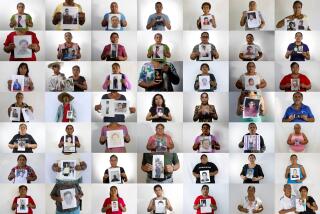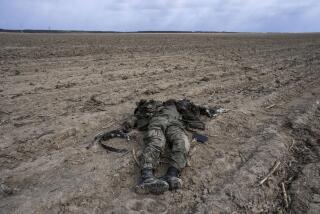Iraq’s numbers don’t add up, U.S. says
BAGHDAD — As U.S. forces begin to scale back in Iraq, the military is becoming increasingly reliant on Iraqi forces to report a wide array of crucial statistics, from the number of attacks on the local infrastructure to how many Iraqi civilians have been killed or wounded.
And just as Iraqi forces have had a mixed record in fighting insurgents, they have been spotty at providing data from the regions where they have taken command.
Iraqi officials have been reporting far higher civilian death totals than those reported by U.S. forces, and aides to American commanders now acknowledge that the U.S. military probably had been undercounting such casualties.
Strategists for Army Gen. David H. Petraeus, the top U.S. commander here, said they were beginning to incorporate Iraqi tallies into their own, but underscored that though the totals might be different, the trends in both Iraqi and American numbers show dramatic decreases in civilian deaths since the summer.
Also troubling to the United States is the frequent failure of Iraqi forces to report data on incidents occurring in the regions where they take the lead in providing security. In sectors handed over to Iraqi army and police forces, U.S. planners have seen a sharp decrease in overall data, severely hampering their ability to determine whether their military plan is succeeding.
The questionable nature of the Iraqi-compiled data, which is expected to become even more problematic as U.S. forces shrink back to pre-buildup levels over the next six months, has placed American commanders in an awkward position.
The more successful they are in turning over military responsibility to Iraqis, the U.S. officials think, the less likely they are to get reliable evidence that their techniques are working.
Statistics have been a key component in Petraeus’ effort to convince the American public and elected officials in Washington that U.S.-led forces are finally making progress in Iraq.
Unreliable data also poses a practical problem. Petraeus and Army Lt. Gen. Raymond T. Odierno, who is in charge of day-to-day operations in Iraq, receive extended daily briefings on the number and location of attacks, the performance of essential services and discoveries of weapons caches, and use the information to make adjustments to their war plan.
“Our presence decreases and we have a greater reliance on information that is to be provided from the host nation, Iraqis, so we can maintain situational awareness on what is going on,” said Army Lt. Col. Todd Gesling, a top officer on Petreaus’ planning staff. “That’s the crux of the problem. . . . The Iraqis don’t have a robust culture of reporting things.”
Aides said charts showing the rise and recent fall in violence and casualties have become regular features of the general’s presentations to visiting congressional delegations, and are expected to feature prominently in the military’s March update in Washington, as they did during Petraeus’ high-profile congressional testimony in September.
Even with about 160,000 troops still in Iraq, the United States’ own record-keeping has been controversial, with Iraqi sources and international observers often reporting much higher levels of civilian casualties.
For much of the time after the March 2003 U.S.-led invasion, American officials said they did not track civilian deaths. Petraeus’ aides say his counterinsurgency strategy, which focuses on protecting the Iraqi population, has led them to try to compile such figures accurately to gauge whether the troop buildup has made people safer.
The conflicting figures frequently arise from incidents in which the U.S. asserts it has killed insurgents whereas Iraqi officials and witnesses say civilians died.
This month, local leaders in Tarmiya, north of Baghdad, said about 40 members of a citizens group working with U.S. forces to flush insurgents from the area were doing a nighttime assault when they were killed by U.S. forces who mistook them for rebels. American officials said 25 people died in the attack, all insurgents.
Similarly, in October, the Iraqi government lashed out at the U.S. military after clashes in Sadr City. Iraqi officials said several civilians were killed, but U.S. forces called the dead “criminals.”
Independent monitoring groups have accused the United States of playing down civilian death counts to make the troop buildup look more successful. But with no official Iraqi system in place to tally civilian death figures, there remains little agreement on the actual number. Estimates have ranged from the tens of thousands to 1.2 million dead.
Aides to Petraeus and Odierno, speaking at a two-day round table with military writers here at military headquarters at Camp Victory, acknowledged that they probably had undercounted civilian casualties in Iraq and said they had changed the way they gather such information, using data gathered from Iraqi sources.
American officers say that trends in both U.S. and “host nation” reporting show that violence has decreased substantially over the last four months.
“The trends are the same; the magnitude is different,” said Army Col. Bill Rapp, head of Petreaus’ small in-house group of advisors. “He reports both, and our guess is truth is in between that range.”
Such statistics are regularly used by both Iraqis and the American military. The U.S. command spent much of the summer in a well-publicized spat with the Iraqi Health Ministry, then dominated by followers of the Shiite Muslim cleric Muqtada Sadr, over the number of dead Iraqis being dumped on the streets of Baghdad and at local morgues.
Rapp accused Sadr of using “inflated” death statistics to undermine the Iraqi government and the U.S. troop buildup, which had just begun.
“They had very much an agenda to discredit the government of Iraq, to discredit the security situation,” Rapp said.
With staffing changes at the Health Ministry, the difference between American and Iraqi estimates of civilian deaths has decreased, but still varies by as much as 500 per month.
Of equal concern to U.S. military analysts, however, is not the over-counting but the lack of any counting at all.
The effect has already become evident in southern Iraq, where British troops have withdrawn from the four provinces they once patrolled and are now based at the airfield outside Basra, making few forays into the city, Iraq’s second-largest.
During the first three weeks of November, for example, Iraqi security forces reported finding more than 250 weapons caches nationwide. But in the south, the discovery of only one cache was reported.
Air Force Col. David Larivee, Petraeus’ chief of assessments, said the reason could simply be the relatively low levels of violence in the Shiite-dominated south. But he acknowledged that it also could be a result of political or cultural reluctance to tell the central government and U.S. forces the true state of security in Basra.
“We’re probably not seeing everything that’s going on in Basra,” Rapp said. “We’re not getting a whole lot of reports because the Brits are on the airfield and they’re not out so much in the town.”
Although Petraeus’ aides are confident that they receive all data that Iraqi forces send to Prime Minister Nouri Maliki, they remain concerned that sectarian politics at the provincial level may mean that incidents that are well-documented by Iraqi troops are not forwarded to Baghdad. “Either they’re not reporting, or they’re getting stopped along the way and not getting to him,” Rapp said.
Politics aside, senior U.S. officers said even the small number of incident reports they get from Iraqi forces, which come in at a rate of about 70 per month, compared with 200 from U.S. forces, lack details and specifics, making them of little use.
In addition, unlike U.S. forces, which check and recheck initial reports from the field -- including sending Special Forces to morgues after especially large insurgent attacks and setting up an entire brigade, Task Force Troy, to conduct forensic detective work on deadly roadside bombs -- Iraqi forces rarely respond to U.S. requests for reinvestigating incidents.
“I will tell you that typically, the initial report is the only report that comes in,” said Gesling. “There has been very limited success in being able to reach down and get additional clarification on reports that have already been forwarded.”
U.S. officials believe Iraqi military and police forces, with training, will become more comprehensive, and they say they have already seen some improvement in the number and details of incident reports.
But huge gaps remain. In October, for example, the entire command and control system used by Iraqi security forces to communicate with headquarters was shut down for two weeks when the government failed to pay the U.S. contractor that provides the satellite communications.
For those two weeks, U.S. commanders and the Iraqi government received no reports from Iraqi forces in the field.
“This isn’t the only instance it occurred” Gesling said.
--
Times staff writer Tina Susman contributed to this report.
More to Read
Sign up for Essential California
The most important California stories and recommendations in your inbox every morning.
You may occasionally receive promotional content from the Los Angeles Times.










